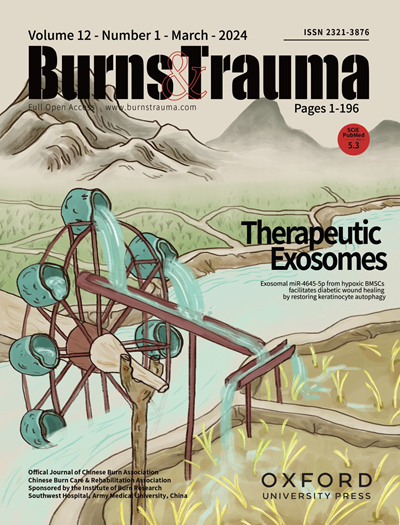Self-Organizing 3D Dermal Papilla Cell Spheroids Yield Therapeutic Extracellular Vesicles that Target Hypertrophic Scar Regression via the miR-26a-5p/CCNE2 Axis
IF 9.6
1区 医学
Q1 DERMATOLOGY
引用次数: 0
Abstract
Background Hypertrophic scarring remains a critical challenge in regenerative medicine because of the limited efficacy of current antifibrotic therapies. Although dermal papilla cells (DPCs) exhibit intrinsic scar-inhibitory potential, their therapeutic utility is constrained by rapid replicative senescence and poor scalability in traditional monolayer cultures, necessitating innovative strategies to enhanceincrease cellular functionality and manufacturing feasibility. Methods A self-feeder layer 3D (SFL-3D) platform was established to reprogram primary human DPCs into rejuvenated tdDPC spheroids via autocrine–paracrine signalling activation. tdDPC-derived extracellular vesicles (tdDPC-EVs) were isolated from culture supernatants by differential centrifugation. The antifibrotic effects of tdDPC-EVs were systematically evaluated using human scar fibroblasts (HSFs) through scratch wound healing assays, CCK-8 proliferation assays, and fibrotic marker analysis (Western blotting and immunofluorescence staining for α-SMA and collagen I). Bioinformatics was used to predict key pathways involved in hypertrophic scar (HS) pathogenesis, whereas gain/loss-of-function studies investigated the miR-26a-5p/CCNE2 regulatory axis. Therapeutic validation was performed in a rabbit ear hypertrophic scar model with histopathological and molecular profiling. Results Compared with conventional 3D cultures, the SFL-3D system demonstrated superior proliferative support, enabling stable tdDPC expansion beyond 10 passages while maintaining high viability and enhanced EV biogenesis. miR-26a-5p-enriched tdDPC-EVs attenuated fibrosis through two mechanisms: (1) silencing CCNE2 to block PI3K/AKT-driven collagen overproduction and (2) suppressing α-SMA+ myofibroblast differentiation. In the rabbit ear HS model, tdDPC-EV administration reduced the scar elevation index and restored the collagen I/III ratio to near-physiological levels. Conclusions This study positions tdDPC-EVs as a scalable acellular therapy that overcomes the replicative senescence and manufacturing limitations of cellular approaches. The antiscarring efficacy of these EVs, which is mediated by the miR-26a-5p/CCNE2/PI3K/AKT axis, highlights their clinical potential as precision-targeted strategies for hypertrophic scar management. The SFL-3D platform further provides a translatable framework for EV-based regenerative therapeutics.自组织3D真皮乳头细胞球体通过miR-26a-5p/CCNE2轴产生靶向增生性瘢痕消退的治疗性细胞外囊泡
背景:由于目前抗纤维化疗法的疗效有限,增生性瘢痕形成仍然是再生医学的一个关键挑战。尽管真皮乳头细胞(DPCs)具有内在的疤痕抑制潜力,但其治疗效用受到传统单层培养中快速复制衰老和可扩展性差的限制,因此需要创新策略来增强细胞功能和制造可行性。方法建立自馈层3D (self-feeder layer 3D, SFL-3D)平台,通过自分泌-旁分泌信号激活将原代人dpc重编程为再生的tdDPC球体。采用差速离心从培养上清中分离出tddpc衍生的细胞外囊泡(tddpc - ev)。采用人瘢痕成纤维细胞(HSFs),通过抓伤愈合试验、CCK-8增殖试验和纤维化标志物分析(α-SMA和I型胶原的Western blotting和免疫荧光染色),系统评价tdDPC-EVs的抗纤维化作用。生物信息学用于预测肥厚性疤痕(HS)发病机制的关键途径,而功能获得/功能丧失研究则研究了miR-26a-5p/CCNE2调控轴。在兔耳增生性瘢痕模型中进行了组织病理学和分子图谱的治疗验证。结果与传统3D培养相比,SFL-3D培养系统具有更好的增殖支持能力,可使tdDPC在10代以上稳定扩增,同时保持较高的活力并增强EV的生物发生。富集mir -26a-5p的tdDPC-EVs通过两种机制减轻纤维化:(1)沉默CCNE2以阻断PI3K/ akt驱动的胶原过度生成;(2)抑制α-SMA+肌成纤维细胞分化。在兔耳HS模型中,tdDPC-EV可降低瘢痕升高指数,使胶原I/III比值恢复到接近生理水平。该研究将tddpc - ev定位为一种可扩展的非细胞治疗方法,克服了细胞方法的复制衰老和制造限制。这些ev的抗疤痕效果是由miR-26a-5p/CCNE2/PI3K/AKT轴介导的,这凸显了它们作为增生性疤痕管理精准靶向策略的临床潜力。SFL-3D平台进一步为基于ev的再生治疗提供了可翻译的框架。
本文章由计算机程序翻译,如有差异,请以英文原文为准。
求助全文
约1分钟内获得全文
求助全文
来源期刊

Burns & Trauma
医学-皮肤病学
CiteScore
8.40
自引率
9.40%
发文量
186
审稿时长
6 weeks
期刊介绍:
The first open access journal in the field of burns and trauma injury in the Asia-Pacific region, Burns & Trauma publishes the latest developments in basic, clinical and translational research in the field. With a special focus on prevention, clinical treatment and basic research, the journal welcomes submissions in various aspects of biomaterials, tissue engineering, stem cells, critical care, immunobiology, skin transplantation, and the prevention and regeneration of burns and trauma injuries. With an expert Editorial Board and a team of dedicated scientific editors, the journal enjoys a large readership and is supported by Southwest Hospital, which covers authors'' article processing charges.
 求助内容:
求助内容: 应助结果提醒方式:
应助结果提醒方式:


